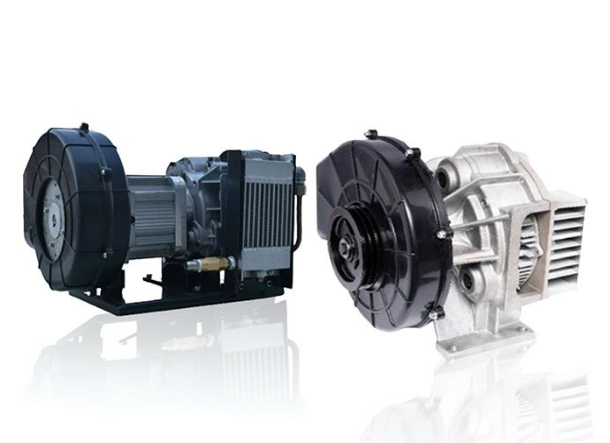Why should you consider using an oil-free vacuum pump?
An oil-free vacuum pump, also known as a dry running vacuum pump or oil-less vacuum pump, uses fluids or oils instead of oil to lubricate bearing chambers or gears. This means that the vacuum chamber doesn't contain any fluid, which can lead to less maintenance and a cleaner environment. Oil-free vacuum pumps also don't get affected by dust particles or vapor, so they last longer and require less maintenance.
Why should you consider using an oil-free vacuum pump?
1. A low energy solution:
Oil-free vacuum technologies offer significant energy efficiency savings. When paired with a VSD (variable speed drive), oil-free vacuum pumps can reduce energy consumption by up to 50% in certain applications compared to oil-lubricated equivalents. The Specific Energy Requirement (SER) measures the power consumption of the vacuum pump relative to the pumping speed and suction pressure. Oil-free vacuum pumps typically achieve a much lower SER, especially when tailored to specific application requirements. Many oil-free technologies are compatible with VSDs, allowing for precise process control and further energy reduction.
2. A clean solution:
For processes demanding stringent air purity levels, oil-free vacuum pumps provide an efficient and reliable solution. These pumps are designed to meet the requirements of manufacturers operating in environments where air purity is of utmost importance.
3. A low maintenance solution:
Oil-free vacuum pumps offer reduced maintenance costs compared to oil-lubricated machines. They eliminate the need for oil and separator element replacements, which are common maintenance tasks in oil-lubricated pumps, resulting in higher operating costs over the pump’s lifespan.
4. A low downtime solution:
Unlike oil-lubricated pumps, oil-free vacuum pumps do not require removal for essential maintenance servicing. This minimizes equipment downtime and reduces indirect costs associated with lost production uptime.
5. An environmentally friendly solution:
Oil-free vacuum pumps eliminate the need for lubricants, reducing waste oil disposal costs and labor. They also contribute to lower oil consumption in manufacturing processes, reducing the environmental impact associated with oil production and waste oil disposal.
6. A lower total cost of ownership solution:
Considering reduced service and maintenance costs, along with energy savings, oil-free vacuum pumps offer significantly lower total cost of ownership (TCO) over their lifespan compared to oil-lubricated pumps. Although the initial investment in an oil-lubricated solution may seem attractive, the long-term lifetime costs favor oil-free vacuum pumps.
Features of Oil-Free Vacuum Pumps:
1. Oil-Free Operation: Oil-free vacuum pumps operate without the need for lubricating oil, eliminating the risk of oil contamination in the vacuum system.
2. Clean and Dry Vacuum: These pumps provide a clean and dry vacuum, making them suitable for applications where oil contamination could interfere with processes or affect the quality of the final product.
3. Low Maintenance: Oil-free vacuum pumps generally require less maintenance compared to oil-sealed pumps. They don’t involve oil changes or regular monitoring of oil levels.
4. Compact Design: Many oil-free vacuum pumps are compact and lightweight, making them suitable for benchtop or portable applications.
5. Quiet Operation: These pumps often operate with lower noise levels, contributing to a quieter working environment.
6. Chemical Resistance: Oil-free vacuum pumps are designed with materials that resist corrosion and damage from chemical exposure, making them suitable for a variety of applications.
7. Variable Vacuum Levels: Some models allow for adjustable vacuum levels, providing flexibility for different applications and processes.
8. Energy Efficiency: Oil-free vacuum pumps are often designed with energy-efficient features, contributing to reduced power consumption.
9. Environmental Friendliness: The absence of oil in the pump makes it more environmentally friendly, as there is no risk of oil disposal or contamination.
10. Long Service Life: With proper maintenance, oil-free vacuum pumps can have a long service life, providing reliable vacuum generation over an extended period.
Advantages and disadvantages
The oil-free vacuum pump is a mechanical vacuum pump that can operate without any oil lubrication. The utility model has the advantages of simple structure, easy operation, convenient maintenance and no pollution to the environment. The oil-free vacuum pump is highly durable and serves as both a vacuum and compression pump, making it versatile for various applications requiring vacuum.
In comparison to oil pumps, oil-free vacuum pumps typically offer lower vacuum levels and pumping capacities. However, they boast a compact size, easy installation, simple maintenance, portability, absence of emissions, and environmental friendliness. These qualities make them particularly suitable for environments with stringent cleanliness requirements, such as laboratories, where they are commonly used.
When purchasing an oil-free vacuum pump, it's crucial to first determine the required vacuum level for the intended application. Selecting a pump with a higher vacuum capacity than needed ensures that the vacuum requirements are adequately met. Additionally, considering the pumping rate of the pump slightly exceeding the required rate enhances its suitability for the task. Finally, it's essential to assess whether the gases being extracted are corrosive, as corrosive gases can damage the pump, necessitating the use of specialized materials to meet operational demands.

评论
发表评论